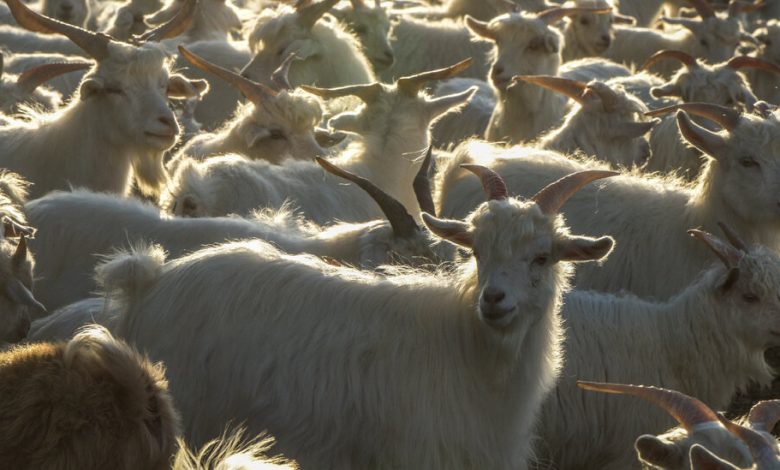This Holiday, Consider the True Cost of Cheap Cashmere

A decade or more ago, it wasn’t uncommon to pay several hundred dollars for a cashmere sweater. Now, as the holiday season approaches, advertisements offer cashmere sweaters at less than half that price. An ad campaign on Instagram from the retailer Quince boasts, “This $50 cashmere sweater is worth the hype!”
A cozy cashmere sweater at a bargain price may seem like a win for consumers. But it comes at a steep cost to one of our most fragile environmental systems — the grasslands of the Mongolian Plateau in Central Asia.
Every cashmere sweater begins with a goat. The fibers are woven from the soft downy undercoat of several breeds. These days, most cashmere fiber comes from the cold, arid steppes of China and Mongolia — a pastureland of immense size and scale, about a million square miles, where for centuries seminomadic herders have raised sheep, horses, yaks, camels and other livestock. Demand for cashmere has grown so much that goats have become the dominant animal in many herds.
As a scientist who visits and studies the Mongolian Plateau, I have witnessed the toll that expanding herds of cashmere goats have had on the environment. Goats are much more destructive than other livestock to grassland ecosystems, like those of the Central Asian steppe. Whereas sheep nibble the tops of grasses but leave the base and roots intact, goats eat plants down to the roots so they cannot regrow, degrading habitat and causing soil erosion. These grasslands are particularly difficult to restore once the vegetation is removed and soils are damaged; in the most heavily impaired areas, grasses are displaced by shrubs and sand.
An estimated 27.5 million goats graze the grasslands of Mongolia (the government does not distinguish between cashmere and noncashmere goats, but cashmere goats predominate); in the Inner Mongolia region of China, the overall number is about 15 million. A 2018 national report on Mongolia’s rangeland found that nearly 58 percent had been degraded to various degrees from grazing as of 2016, with 23 percent classified as either heavily or fully degraded.
Goats that graze on rangelands in poor condition produce shorter, thicker fibers that fetch lower prices in the market, forcing some herders to increase their herd sizes to make ends meet. Manufacturers use these subpar fibers to create the affordable cashmere sweaters that are now a staple of the holiday shopping season. These garments fall short in terms of durability compared with those made from high-quality wool. The very essence of what makes cashmere luxurious — softness, warmth and longevity — is compromised, at a huge environmental cost.
Even so, retailers are marketing cashmere by tapping into consumer desire for eco-conscious products, with sales pitches like “100 percent Inner Mongolian two-ply cashmere.” By labeling garments this way, retailers no doubt hope consumers will assume that the sourcing of this cashmere equates to quality, but the overture is essentially meaningless. Most cashmere comes from that region anyway, and it is difficult to validate claims of sustainability.
By sustainability, I mean that the cashmere should come from goats grazed on pasture where there is either no change to the condition of the grasslands or an improvement. But this would require most herders to reduce their herds. Monitoring, moreover, is difficult in a region so remote, and there is little transparency or effort to do monitoring among the brands.
For consumers looking to make more environmentally conscious shopping choices, sustainable cashmere ultimately may be unattainable. The global market for cashmere was valued at $3.2 billion in 2022 and is projected to grow to $4.4 billion by 2030. At that scale of consumption, it may be nearly impossible to sustainably produce $200 cashmere sweaters, let alone cashmere sweaters selling for $50.
Efforts are underway to develop sustainable production practices. The Germany-based Aid by Trade Foundation has begun a certification program targeting farms producing cashmere in Inner Mongolia. And the Sustainable Fiber Alliance, a nongovernmental organization based in Britain and Mongolia, is developing a sustainable cashmere standard for its members. Last January, the alliance joined with a business group that advises brands on commercial supply chain issues, to form the Rangeland Stewardship Council, an effort to connect brands with herders who are trying to produce fibers sustainably. And brands like Everlane and Patagonia are offering garments made from recycled cashmere.
My view is this: From an environmental perspective, the best solution is to forgo cashmere altogether. Wool from sheep, yaks or camels can still be made into very soft fabrics. These animals can also produce much more fiber a year than cashmere goats without causing the same level of ecological damage. Or consider vintage cashmere.
The reality of cashmere encompasses more than the warmth of a sweater or the allure of a holiday bargain. It is about the preservation of an ecosystem, the livelihoods of herders and the longevity of a once-luxurious fabric. Change is in the hands of consumers and retailers.
Consumers must understand the consequences of their choices. These decisions reverberate through supply chains, shaping industry practices. At a minimum, by choosing quality sweaters over cheap ones, consumers can hold retailers accountable for their sourcing and encourage a more sustainable future for the cashmere industry.
But consumers also need to shift their preferences to garments made from fibers with a lighter ecological footprint. The true cost of cheap cashmere is too high a price to pay for a fleeting sense of luxury.
Ginger Allington is a landscape ecologist and an assistant professor in the department of natural resources and the environment at Cornell. Her research has focused on the arid rangelands of the Mongolian plateau.
The Times is committed to publishing a diversity of letters to the editor. We’d like to hear what you think about this or any of our articles. Here are some tips. And here’s our email: [email protected].
Follow the New York Times Opinion section on Facebook, Instagram, TikTok, X and Threads.



